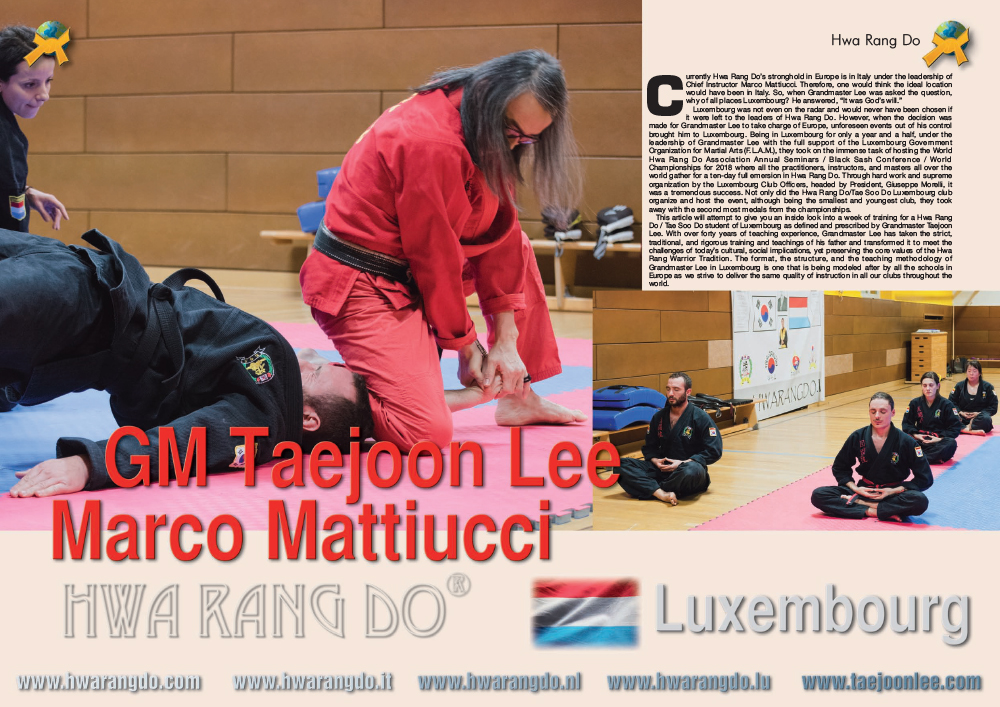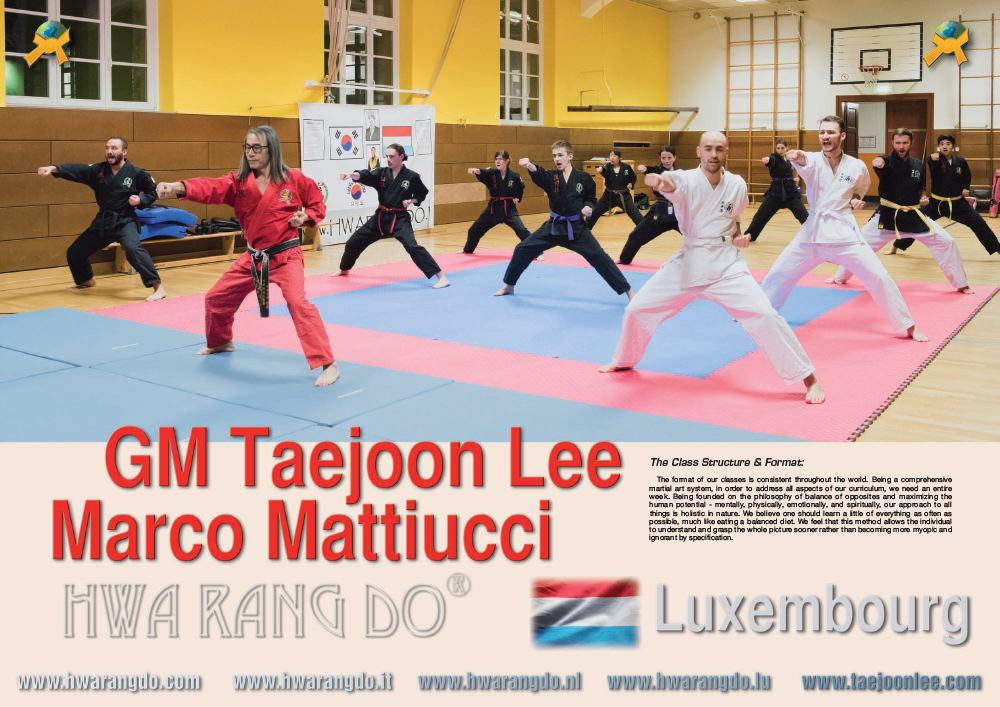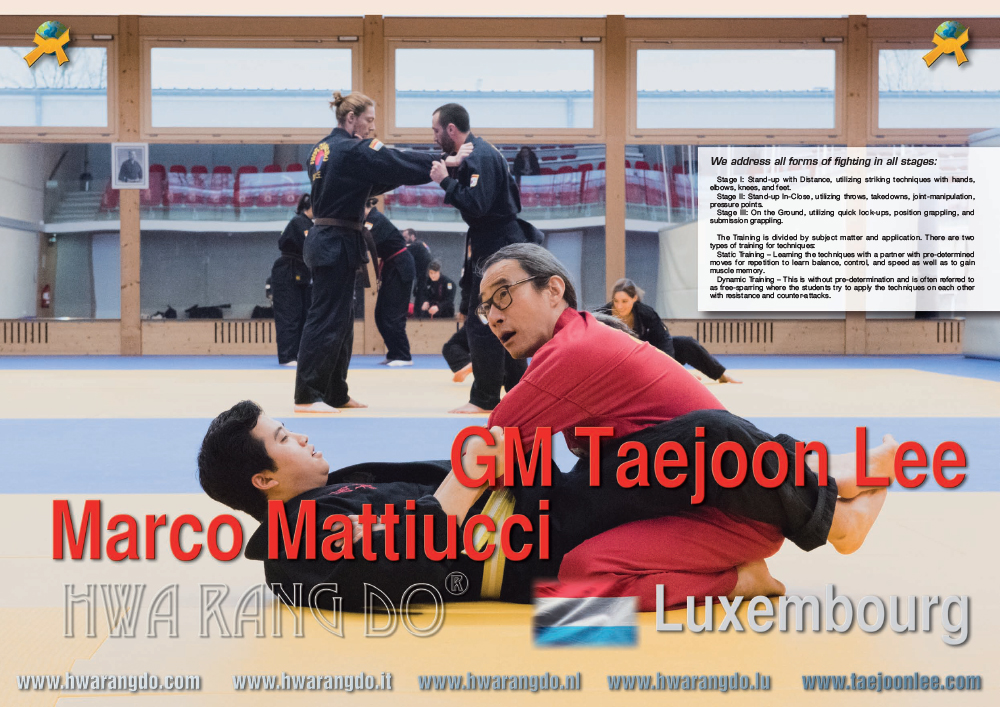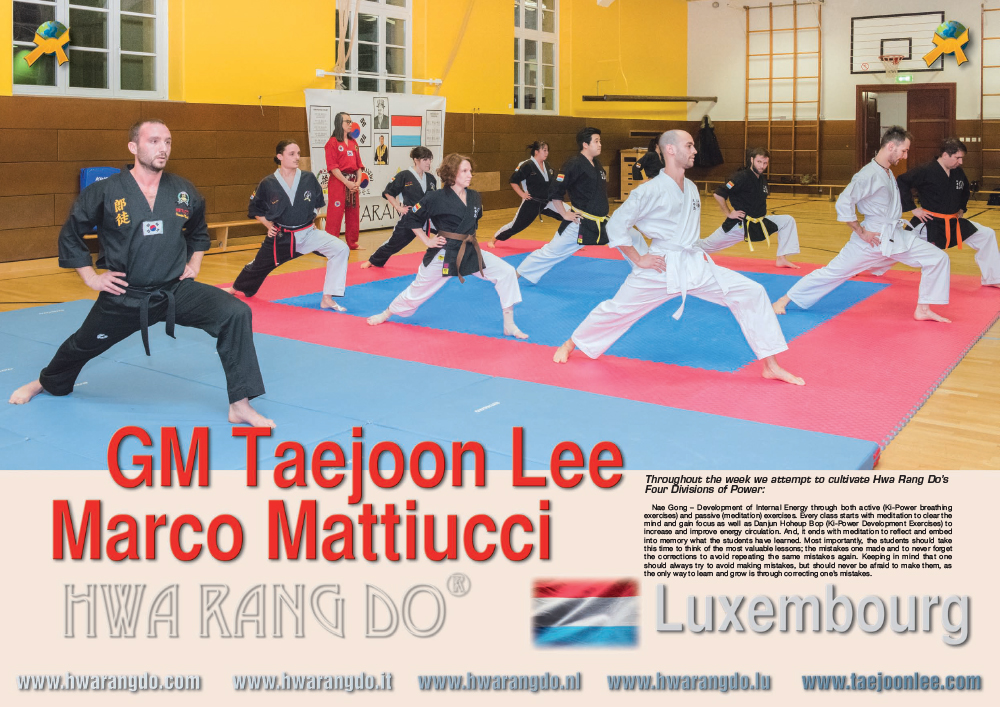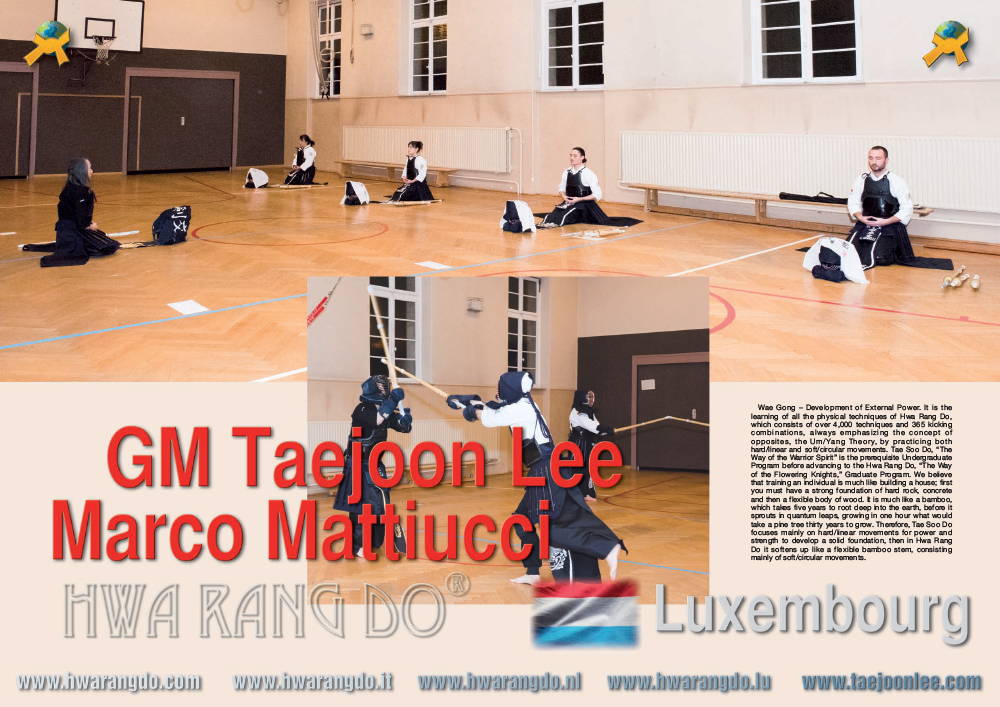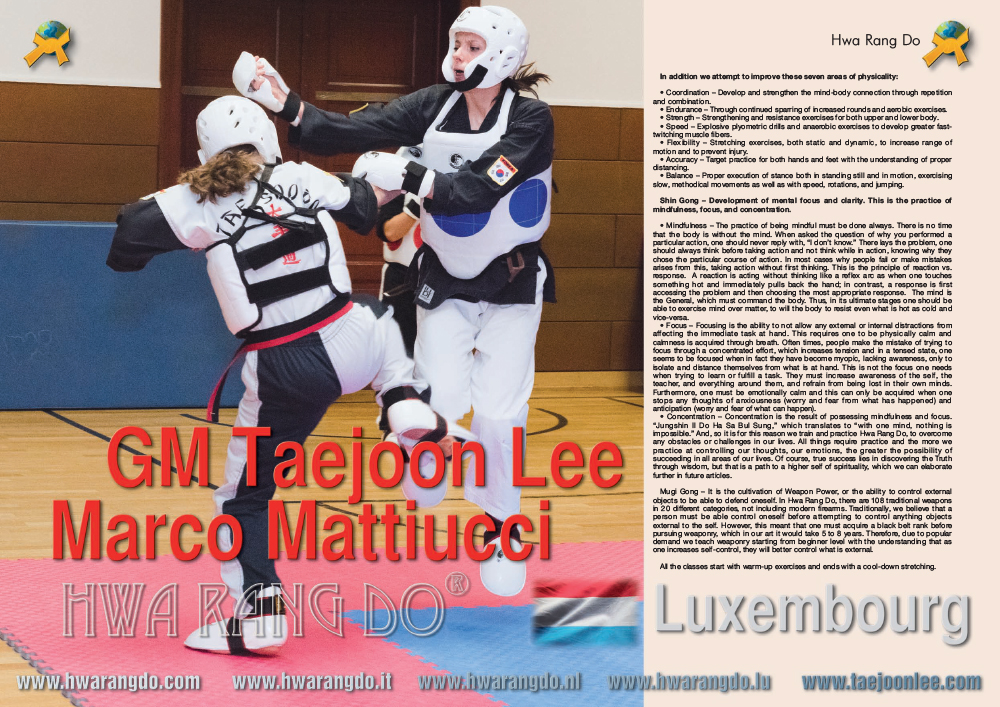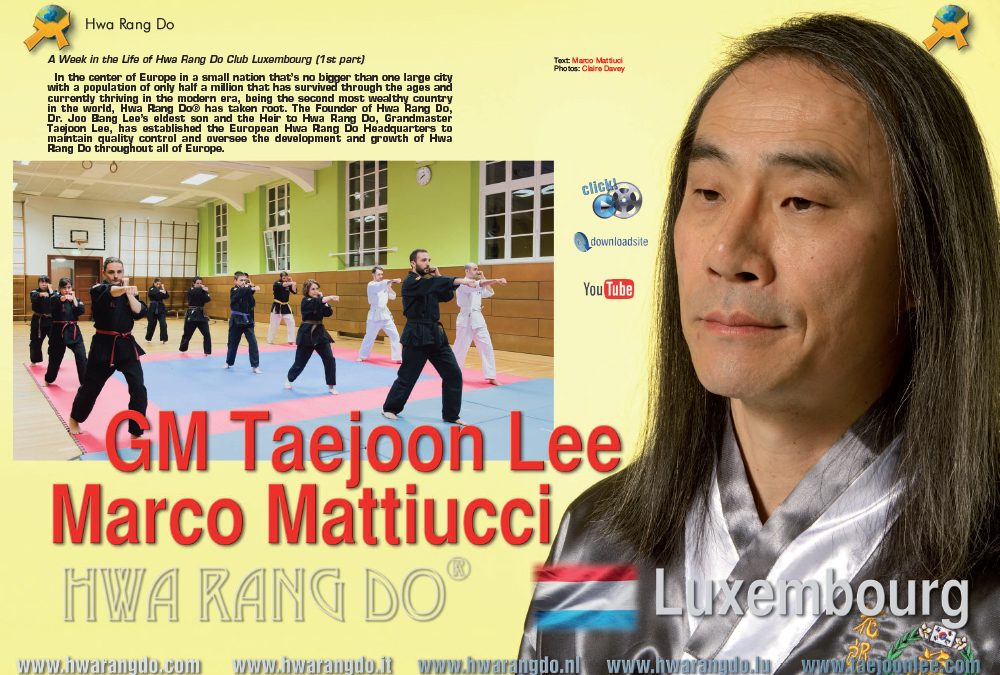A Week in the Life of Hwa Rang Do Club Luxembourg (Part 1)
Published in Budo International March 2019 Issue
In the center of Europe in a small nation that’s no bigger than one large city with a population of only half a million that has survived through the ages and currently thriving in the modern era, being the second most wealthy country in the world, Hwa Rang Do® has taken root. The Founder of Hwa Rang Do, Dr. Joo Bang Lee’s eldest son and the Heir to Hwa Rang Do, Grandmaster Taejoon Lee, has established the European Hwa Rang Do Headquarters to maintain quality control and oversee the development and growth of Hwa Rang Do throughout all of Europe.
Currently Hwa Rang Do’s stronghold in Europe is in Italy under the leadership of Chief Instructor Marco Mattiucci. Therefore, one would think the ideal location would have been in Italy. So, when Grandmaster Lee was asked the question, why of all places Luxembourg? He answered, “It was God’s will.”
Luxembourg was not even on the radar and would never have been chosen if it were left to the leaders of Hwa Rang Do. However, when the decision was made for Grandmaster Lee to take charge of Europe, unforeseen events out of his control brought him to Luxembourg. Being in Luxembourg for only a year and a half, under the leadership of Grandmaster Lee with the full support of the Luxembourg Government Organization for Martial Arts (F.L.A.M.), they took on the immense task of hosting the World Hwa Rang Do Association Annual Seminars / Black Sash Conference / World Championships for 2018 where all the practitioners, instructors, and masters all over the world gather for a ten-day full emersion in Hwa Rang Do. Through hard work and supreme organization by the Luxembourg Club Officers, headed by President, Giuseppe Morelli, it was a tremendous success. Not only did the Hwa Rang Do/Tae Soo Do Luxembourg club organize and host the event, although being the smallest and youngest club, they took away with the second most medals from the championships.
This article will attempt to give you an inside look into a week of training for a Hwa Rang Do / Tae Soo Do student of Luxembourg as defined and prescribed by Grandmaster Taejoon Lee. With over forty years of teaching experience, Grandmaster Lee has taken the strict, traditional, and rigorous training and teachings of his father and transformed it to meet the challenges of today’s cultural, social implications, yet preserving the core values of the Hwa Rang Warrior Tradition. The format, the structure, and the teaching methodology of Grandmaster Lee in Luxembourg is one that is being modeled after by all the schools in Europe as we strive to deliver the same quality of instruction in all our clubs throughout the world.
The Class Structure & Format:
The format of our classes is consistent throughout the world. Being a comprehensive martial art system, in order to address all aspects of our curriculum, we need an entire week. Being founded on the philosophy of balance of opposites and maximizing the human potential – mentally, physically, emotionally, and spiritually, our approach to all things is holistic in nature. We believe one should learn a little of everything as often as possible, much like eating a balanced diet. We feel that this method allows the individual to understand and grasp the whole picture sooner rather than becoming more myopic and ignorant by specification.
We address all forms of fighting in all stages:
Stage I: Stand-up with Distance, utilizing striking techniques with hands, elbows, knees, and feet.
Stage II: Stand-up In-Close, utilizing throws, takedowns, joint-manipulation, pressure points.
Stage III: On the Ground, utilizing quick lock-ups, position grappling, and submission grappling.
The Training is divided by subject matter and application. There are two types of training for techniques:
Static Training – Learning the techniques with a partner with pre-determined moves for repetition to learn balance, control, and speed as well as to gain muscle memory.
Dynamic Training – This is without pre-determination and is often referred to as free-sparring where the students try to apply the techniques on each other with resistance and counter-attacks.
Throughout the week we attempt to cultivate Hwa Rang Do’s Four Divisions of Power:
Nae Gong – Development of Internal Energy through both active (Ki-Power breathing exercises) and passive (meditation) exercises. Every class starts with meditation to clear the mind and gain focus as well as Danjun Hoheup Bop (Ki-Power Development Exercises) to increase and improve energy circulation. And, it ends with meditation to reflect and embed into memory what the students have learned. Most importantly, the students should take this time to think of the most valuable lessons; the mistakes one made and to never forget the corrections to avoid repeating the same mistakes again. Keeping in mind that one should always try to avoid making mistakes, but should never be afraid to make them, as the only way to learn and grow is through correcting one’s mistakes.
Wae Gong – Development of External Power. It is the learning of all the physical techniques of Hwa Rang Do, which consists of over 4,000 techniques and 365 kicking combinations, always emphasizing the concept of opposites, the Um/Yang Theory, by practicing both hard/linear and soft/circular movements. Tae Soo Do, “The Way of the Warrior Spirit” is the prerequisite Undergraduate Program before advancing to the Hwa Rang Do, “The Way of the Flowering Knights,” Graduate Program. We believe that training an individual is much like building a house; first you must have a strong foundation of hard rock, concrete and then a flexible body of wood. It is much like a bamboo, which takes five years to root deep into the earth, before it sprouts in quantum leaps, growing in one hour what would take a pine tree thirty years to grow. Therefore, Tae Soo Do focuses mainly on hard/linear movements for power and strength to develop a solid foundation, then in Hwa Rang Do it softens up like a flexible bamboo stem, consisting mainly of soft/circular movements.
In addition we attempt to improve these seven areas of physicality:
- Coordination – Develop and strengthen the mind-body connection through repetition and combination.
- Endurance – Through continued sparring of increased rounds and aerobic exercises.
- Strength – Strengthening and resistance exercises for both upper and lower body.
- Speed – Explosive plyometric drills and anaerobic exercises to develop greater fast-twitching muscle fibers.
- Flexibility – Stretching exercises, both static and dynamic, to increase range of motion and to prevent injury.
- Accuracy – Target practice for both hands and feet with the understanding of proper distancing.
- Balance – Proper execution of stance both in standing still and in motion, exercising slow, methodical movements as well as with speed, rotations, and jumping.
Shin Gong – Development of mental focus and clarity. This is the practice of mindfulness, focus, and concentration.
- Mindfulness – The practice of being mindful must be done always. There is no time that the body is without the mind. When asked the question of why you performed a particular action, one should never reply with, “I don’t know.” There lays the problem, one should always think before taking action and not think while in action, knowing why they chose the particular course of action. In most cases why people fail or make mistakes arises from this, taking action without first thinking. This is the principle of reaction vs. response. A reaction is acting without thinking like a reflex arc as when one touches something hot and immediately pulls back the hand; in contrast, a response is first accessing the problem and then choosing the most appropriate response. The mind is the General, which must command the body. Thus, in its ultimate stages one should be able to exercise mind over matter, to will the body to resist even what is hot as cold and vice-versa.
- Focus – Focusing is the ability to not allow any external or internal distractions from affecting the immediate task at hand. This requires one to be physically calm and calmness is acquired through breath. Often times, people make the mistake of trying to focus through a concentrated effort, which increases tension and in a tensed state, one seems to be focused when in fact they have become myopic, lacking awareness, only to isolate and distance themselves from what is at hand. This is not the focus one needs when trying to learn or fulfill a task. They must increase awareness of the self, the teacher, and everything around them, and refrain from being lost in their own minds. Furthermore, one must be emotionally calm and this can only be acquired when one stops any thoughts of anxiousness (worry and fear from what has happened) and anticipation (worry and fear of what can happen).
- Concentration – Concentration is the result of possessing mindfulness and focus. “Jungshin Il Do Ha Sa Bul Sung,” which translates to “with one mind, nothing is impossible.” And, so it is for this reason we train and practice Hwa Rang Do, to overcome any obstacles or challenges in our lives. All things require practice and the more we practice at controlling our thoughts, our emotions, the greater the possibility of succeeding in all areas of our lives. Of course, true success lies in discovering the Truth through wisdom, but that is a path to a higher self of spirituality, which we can elaborate further in future articles.
Mugi Gong – It is the cultivation of Weapon Power, or the ability to control external objects to be able to defend oneself. In Hwa Rang Do, there are 108 traditional weapons in 20 different categories, not including modern firearms. Traditionally, we believe that a person must be able control oneself before attempting to control anything objects external to the self. However, this meant that one must acquire a black belt rank before pursuing weaponry, which in our art it would take 5 to 8 years. Therefore, due to popular demand we teach weaponry starting from beginner level with the understanding that as one increases self-control, they will better control what is external.
All the classes start with warm-up exercises and ends with a cool-down stretching.
